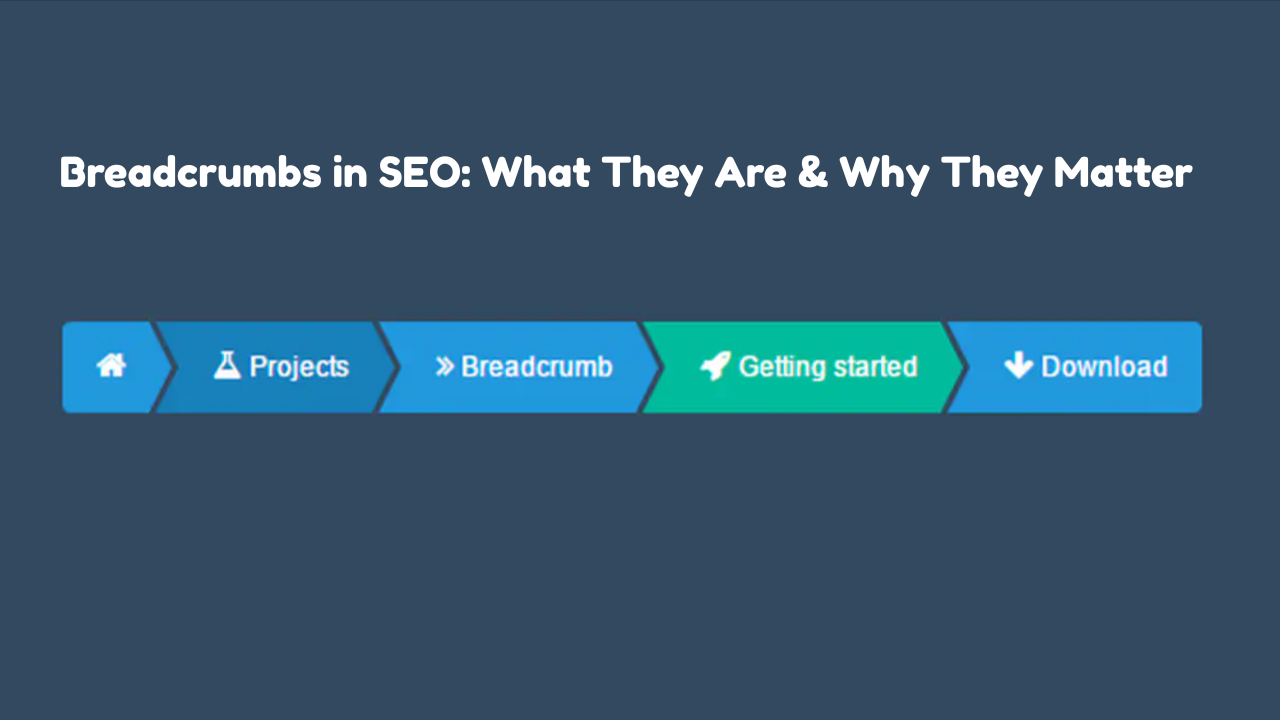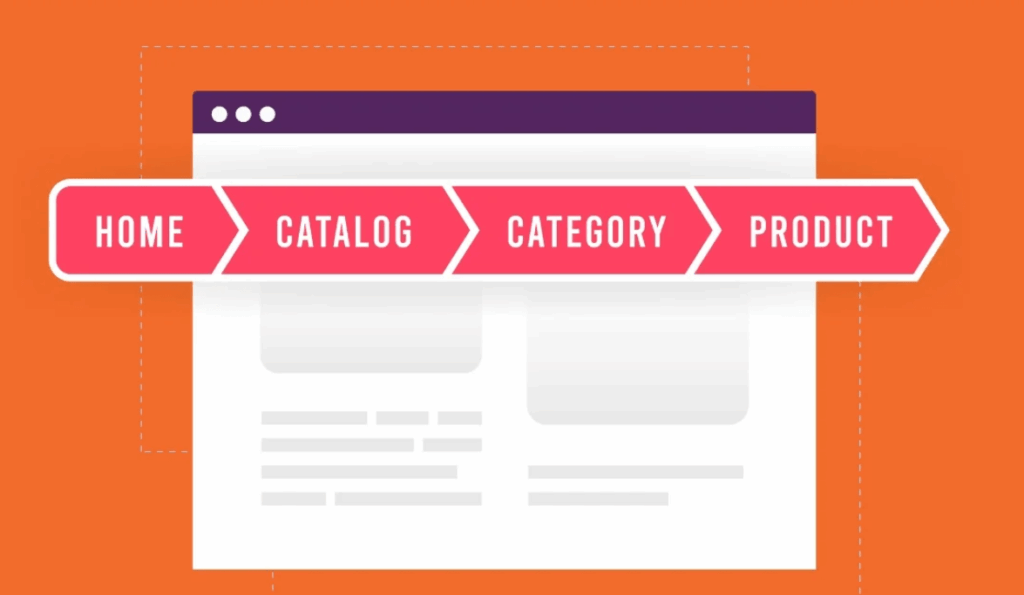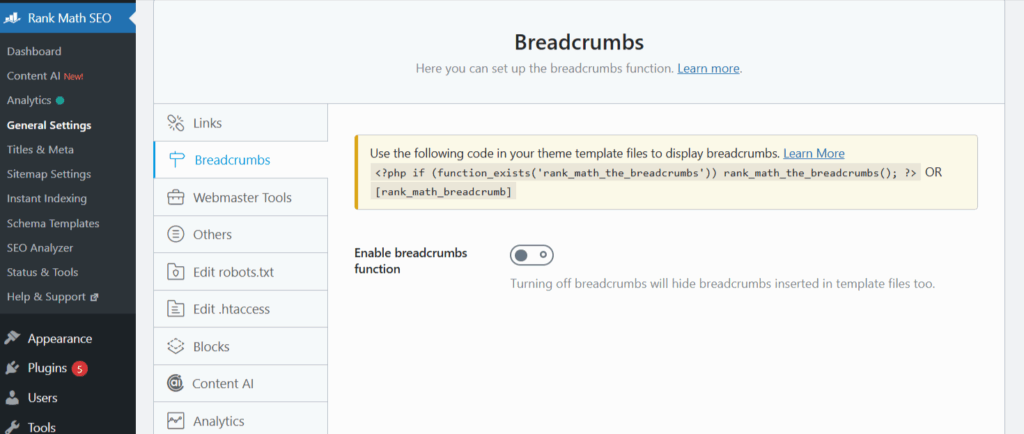
What Are Breadcrumbs in SEO? Definition, Benefits, and Best Practices
- accuindexcheck
- 0
- Posted on
Breadcrumbs represent a navigational feature displaying to users the path followed to come to a specific page within a given website. This process allows visitors to make sense of the stub organization, contributing to enhanced user experience while also allowing easy navigation back to prior pages. From the SEO viewpoint, breadcrumbs aid the search engines with comprehension of your site hierarchy that will add to better indexing and better ranking.
This article explains what breadcrumbs are, how they work, and why they matter for SEO. It explains how breadcrumbs improve user experience and increase your site’s visibility in search engines.
What are Breadcrumbs?
Breadcrumbs are secondary navigation tools that help users see where they are within a website’s structure. Some navigational paths allow the visitor to return to a previous section or higher category area by just clicking instead of pressing the back button in the browser repeatedly. Breadcrumb navigation, from the SEO point of view, is thus an important tool to assist search engine spiders to comprehend the site structure and index it well for providing users with a better experience.
The term “breadcrumbs” was irreverently coined from the classic fairy tale of Hansel and Gretel, in which the children let down trails of breadcrumbs to find their way back home. These breadcrumbs in web navigation are, likewise, an open upstream trail that leads the user through the structure of the site.
How Breadcrumbs Appear on a Website
Typically, breadcrumbs appear as a horizontal trail near the top of a page, positioned below the header or main menu. The sections in the trail are punctuated by some symbols, anything like an arrow “>”, slash “/”, or right arrow “→” of hierarchy.
Example of a breadcrumb trail format:
Home > Catalog > Category > Product

Types of Breadcrumbs
There is no one single type of breadcrumb; various types are used in different capacities based on a website’s structure and functionality. Comparative knowledge of these types will ease the selection process based on the needs of your website.
1. Hierarchy-Based (Location) Breadcrumbs
Hierarchy-type breadcrumbs indicate the page’s location in the general structure of a website starting at the homepage and moving through categories or sections. For example, Home > Blog > SEO Basics > What Are Breadcrumbs. They suit websites that are classically tiered for various categories such as blogs, sites for documentation, and corporate portals. These breadcrumbs essentially help the users and search engines by indicating the content’s hierarchy and thus making it easier for navigation onto the pages on higher levels of the hierarchy.
2. Attribute-Based Breadcrumbs
Attribute-based breadcrumbs show product features or filters instead of the page’s location in the hierarchy. It is the type used in most e-commerce sites exhibiting Men > Shoes > Sports > Size 10, according to a user’s attribute selections. This form of navigation facilitates changing or refining product selections without having to start the filtering process all over. While seemingly not much concerned with SEO structure, they heavily enhance user experience on product-focused or filter-based sites.
3. History-Based Breadcrumbs
While history-based breadcrumbs mimic browser history and display the exact steps the user took to reach the current page, they could be of some use in cases where the path involves multi-step journeys with bookings or forms and provide little SEO value. The only disadvantage is that the pathway displayed may not really correspond to the hierarchy of the site leading to a more confusing user experience.
Benefits of Using Breadcrumbs
User Benefits
Breadcrumbs aid the users in quickly distinguishing where they currently stand on a website and what they can do to reach the rest. This eases the entire UX journey with the user to the relevant content without going frustrating.
- Instant navigation to higher-level pages : Users shouldn’t have to keep searching or clicking on the browser back button whenever they need to move up to an immediate parent category or section.
- Clear understanding of website structure : How breadcrumbs display a visual hierarchy for a page enables the user to clearly understand how deep they are in the site.
- Never use the back button again : Instead of traversing backward on a step-by-step basis visitors are free to choose the desired level to which they want to return.
- Encourages deeper site exploration : Since they show related categories and sections, breadcrumbs may lure users to additional content they were otherwise unlikely to discover.
SEO Benefits
Not only do they help the users, but breadcrumbs also have a significant advantage in assisting search engines in crawling and comprehending a website. They really reinforce internal linkages, increase visibility for content, and even ramp up click-through rates in search engine results.
- Better indexing of deep-level pages : Breadcrumb links assist crawling engines in discovering and indexing pages buried deep within the site’s hierarchy.
- Improved internal link structure : Every breadcrumb provides a meaningful internal link for the site, and it assists in distributing link equity more proficiently across pages.
- Possible higher search rankings : Higher visibility equals higher trust, and search engines are often more inclined to rank a site better if it is well-structured and easy to navigate.
- Enhanced SERP appearance with rich snippets : Google, at times, prefers displaying breadcrumb paths in featured snippets, in lieu of considering URLs of a considerable length, making the listing look attractive and click-worthy.
Breadcrumbs and Mobile SEO
Breadcrumbs have a big role to play in enhancing mobile browsing. They offer users a very clear and compact path of navigation; this in itself is crucial to the mobile experience. Since a much smaller screen space is available and traditional menus can seem too cluttered, users can indeed quickly get a hint of where they are and immediately move back without excessive scrolling or tapping. This increases usability for mobile visitors; hence bounce rates are low.
Why They Are Important for Mobile Navigation
- Compact and Space-Saving : Breadcrumbs take very little space and offer a strong navigation structure; hence, they are ideal for mobile layouts.
- Quick Access to Higher-Level Pages : Instead of opening long menus and scrolling through them, users can reach their desired category or section instantly with these.
- Reduced Cognitive Load : By showing the user path, breadcrumbs prevent confusion and keep the navigation intuitive even with smaller displays.
- Better Engagement : Smooth navigation encourages users to browse more pages, and hence really intends to increase session time.
When to Use Breadcrumbs (and When Not To)
Breadcrumbs work best for websites wherein the structure of hierarchy is clear, with two or more levels of content, whereas one level sites might find them redundant.
Best Scenarios for Implementation
- E-Commerce Websites – Most online stores have several product categories and subcategories. Breadcrumbs allow customers to efficiently navigate back forth between sections.
- Large Content Sites – Any blogging site, press portal, or knowledge-base with a large or deep category structure feed with breadcrumbs for better discovery of content.
- Educational Sites – Any learning site consisting of courses, modules, and lessons would probably benefit from breadcrumbs indicating to users where they currently are in their learning path.
- Service Websites with Multiple Sections – Businesses providing different services in distinct regions can make use of location- or category-based breadcrumbs to guide users efficiently.
Sites That Don’t Need Them
- Single-Page Websites – Breadcrumbs are futile when all the content is on one scrolling page.
- Small Static Sites – With a small set of pages and no hierarchy, the sites have no need for breadcrumb navigation.
- Minimalist Landing Pages – Standalone promotional or lead generation pages should give priority to the forefront call-to-action rather than any other purposeless route navigation.
- Alternative Navigation for Apps or Platforms: The navigation is more understandable and intuitive with one layer. Hence, breadcrumbs can be sacrificed.
How to Implement Breadcrumbs on Your Website
Depending on the platform and ease of implementation, these can be implemented in various ways. Here comes the three very common methods :
1. Manual HTML Implementation
If you have a completely custom setup for your site or simply like tinkering with every pixel of design and layout on your own, manual breadcrumbing using HTML and CSS is an ideal option. This is, after all, the greatest design choice since you can specify every single element with which you feel comfortable: font, spacing, separators, or even responsive traits, without installing plugins or relying on some script.
While there is a bit of a learning curve when it comes to making breadcrumbs by yourself, this option is the one to take when you want to customize performance without some plugin interfering — all the while ensuring your breadcrumbs conform to your site’s branding and harmonize well with your own design.
Here’s a simple HTML example of a breadcrumb trail:
<nav class="breadcrumbs">
<a href="/">Home</a> >
<a href="/products/">Products</a> >
<a href="/products/shoes/">Shoes</a> >
<span>Running Shoes</span>
</nav>2. Using CMS Plugins (WordPress, Shopify, etc.)
If working in a CMS environment, installing it is almost as simple as installing a plugin or toggling a setting; there is no manual code tweak. Perfect for those not wanting to get their hands dirty or having little time for setup. One can change anything from separators, font types, colors, positioning, and so on, and almost all plugins apply Schema.org markup automatically for SEO boost.
Popular Plugin Options
For WordPress
If your website is WordPress-based, then there are several very popular breadcrumb plugins:
- Yoast SEO – Leading the list for SEO optimization, it also comes with a breadcrumb feature by default that integrates well with most WP themes. You can set your custom breadcrumb titles, separators, and hierarchy.
- Breadcrumb NavXT – The one breadcrumb plugin provided for all types of customization to the breadcrumb trail. You can adjust display formats and separators and even include custom post types.
- Rank Math – Another SEO plugin that includes a breadcrumb feature. It is simple to enable, comes with controls for styling, and applies structured data markup for search-enriched search engines automatically.

For Shopify
Shopify makes breadcrumbs easy to implement because the majority of premium themes include breadcrumb navigation out-of-the-box. For those who want a bit more control and added functionality, Category Breadcrumbs or similar apps will take care of customizing the style, separator, and visibility for certain pages or product categories.
For Magento
Magento actually comes with breadcrumbs implemented by default. You can turn breadcrumbs on or off for various page types, move their placement around, or change their appearance through theme settings. There are no extensions needed since it is built into Magento. It also plays well with Magento’s layered navigation for eCommerce sites.
3. Adding Schema Markup for SEO
Once you’ve set your Schema Markup, Google will mostly use your breadcrumbs for display in the search results in place of long, messy URLs with cleaner and more descriptive paths of navigation in the results. It helps make your listings more visible on important SEO terms, as well as provide that glossy look and hence provide ample views from potential traffic.
Example JSON-LD Schema for Breadcrumbs:
<script type=”application/ld+json”>
{
“@context”: “https://schema.org”,
“@type”: “BreadcrumbList”,
“itemListElement”: [
{
“@type”: “ListItem”,
“position”: 1,
“name”: “Home”,
“item”: “https://www.example.com/”
},
{
“@type”: “ListItem”,
“position”: 2,
“name”: “Products”,
“item”: “https://www.example.com/products/”
},
{
“@type”: “ListItem”,
“position”: 3,
“name”: “Shoes”,
“item”: “https://www.example.com/products/shoes/”
}
]
}
</script>
FAQs
What are breadcrumbs in SEO?
Breadcrumbs are a series of clickable links showing the path from the homepage to the currently viewed page, thus assisting the user to retrace their way through the hierarchically arranged site. From the SEO perspective, breadcrumbs help search engines to address page-to-page relationships with the result that they get better indexing and display in search results.
What is an example of breadcrumbs?
Something along the same lines as: Home > Blog > SEO Tips > Breadcrumb Guide is a common example. This clickable trail provides users with a clear indicator of where they are on the website and shortcuts wherein one can quickly jump up to higher-level categories rather than use the back button form the browser.
What is the difference between sitemap and breadcrumbs?
Just as a sitemap will make available a complete list of pages for the search engines- sometimes to help visitors locate particular pages-so too do breadcrumbs provide the present navigation path for a particular page: where that page is located in the site architecture and how it is involved with other sections that can be quickly navigated between.
Do breadcrumbs affect SEO?
Yes, breadcrumbs may assist SEO when it comes to aiding the user for smooth navigation across a site. These breadcrumbs help lower bounce rates and promote visitor exploration of the site. They also aid the search engines in understanding the structure of a website so that breadcrumb-rich snippets can be shown in search results, thereby gaining a greater CTR and visibility.
When to use a breadcrumb?
Breadcrumbs work best when the content is arranged in various levels, as in the case of eCommerce stores, multi-category blogs, and online education platforms. An intelligent hierarchy allows these breadcrumbs to ease a user’s navigation to the deeper sections of an online store.
How to check breadcrumbs in a website?
Generally, breadcrumbs entail navigating to a page and looking for a path up from that page. A technical evaluation may include the use of Google’s Rich Results Test or Search Console’s Breadcrumbs report to verify that they have been implemented correctly in terms of Schema Markup and SEO benefit.
In Conclusion
Breadcrumbs help to bring clarity to the site navigation for the end-user by participating in SEO/SEA and also for the linkage of page hierarchies to search engines. Search engine listings can even be improved through breadcrumbs by outputting well-formed navigation paths instead of long URLs.
The key for website owners is to make sure breadcrumbs are installed correctly for the platform through the CMS plugins, manual coding, or built-in theme features, then optimize them with Schema Markup to obtain the fullest SEO advantage.